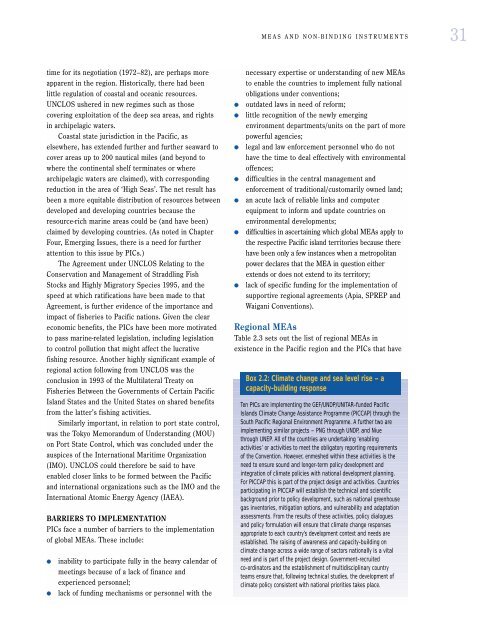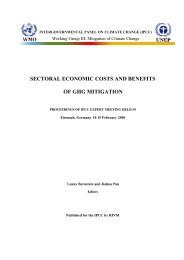Pacific Islands Environment Outlook - UNEP
Pacific Islands Environment Outlook - UNEP
Pacific Islands Environment Outlook - UNEP
Create successful ePaper yourself
Turn your PDF publications into a flip-book with our unique Google optimized e-Paper software.
MEAS AND NON-BINDING INSTRUMENTS 31<br />
time for its negotiation (1972–82), are perhaps more<br />
apparent in the region. Historically, there had been<br />
little regulation of coastal and oceanic resources.<br />
UNCLOS ushered in new regimes such as those<br />
covering exploitation of the deep sea areas, and rights<br />
in archipelagic waters.<br />
Coastal state jurisdiction in the <strong>Pacific</strong>, as<br />
elsewhere, has extended further and further seaward to<br />
cover areas up to 200 nautical miles (and beyond to<br />
where the continental shelf terminates or where<br />
archipelagic waters are claimed), with corresponding<br />
reduction in the area of ‘High Seas’. The net result has<br />
been a more equitable distribution of resources between<br />
developed and developing countries because the<br />
resource-rich marine areas could be (and have been)<br />
claimed by developing countries. (As noted in Chapter<br />
Four, Emerging Issues, there is a need for further<br />
attention to this issue by PICs.)<br />
The Agreement under UNCLOS Relating to the<br />
Conservation and Management of Straddling Fish<br />
Stocks and Highly Migratory Species 1995, and the<br />
speed at which ratifications have been made to that<br />
Agreement, is further evidence of the importance and<br />
impact of fisheries to <strong>Pacific</strong> nations. Given the clear<br />
economic benefits, the PICs have been more motivated<br />
to pass marine-related legislation, including legislation<br />
to control pollution that might affect the lucrative<br />
fishing resource. Another highly significant example of<br />
regional action following from UNCLOS was the<br />
conclusion in 1993 of the Multilateral Treaty on<br />
Fisheries Between the Governments of Certain <strong>Pacific</strong><br />
Island States and the United States on shared benefits<br />
from the latter’s fishing activities.<br />
Similarly important, in relation to port state control,<br />
was the Tokyo Memorandum of Understanding (MOU)<br />
on Port State Control, which was concluded under the<br />
auspices of the International Maritime Organization<br />
(IMO). UNCLOS could therefore be said to have<br />
enabled closer links to be formed between the <strong>Pacific</strong><br />
and international organizations such as the IMO and the<br />
International Atomic Energy Agency (IAEA).<br />
BARRIERS TO IMPLEMENTATION<br />
PICs face a number of barriers to the implementation<br />
of global MEAs. These include:<br />
●<br />
●<br />
inability to participate fully in the heavy calendar of<br />
meetings because of a lack of finance and<br />
experienced personnel;<br />
lack of funding mechanisms or personnel with the<br />
●<br />
●<br />
●<br />
●<br />
●<br />
●<br />
●<br />
necessary expertise or understanding of new MEAs<br />
to enable the countries to implement fully national<br />
obligations under conventions;<br />
outdated laws in need of reform;<br />
little recognition of the newly emerging<br />
environment departments/units on the part of more<br />
powerful agencies;<br />
legal and law enforcement personnel who do not<br />
have the time to deal effectively with environmental<br />
offences;<br />
difficulties in the central management and<br />
enforcement of traditional/customarily owned land;<br />
an acute lack of reliable links and computer<br />
equipment to inform and update countries on<br />
environmental developments;<br />
difficulties in ascertaining which global MEAs apply to<br />
the respective <strong>Pacific</strong> island territories because there<br />
have been only a few instances when a metropolitan<br />
power declares that the MEA in question either<br />
extends or does not extend to its territory;<br />
lack of specific funding for the implementation of<br />
supportive regional agreements (Apia, SPREP and<br />
Waigani Conventions).<br />
Regional MEAs<br />
Table 2.3 sets out the list of regional MEAs in<br />
existence in the <strong>Pacific</strong> region and the PICs that have<br />
Box 2.2: Climate change and sea level rise – a<br />
capacity-building response<br />
Ten PICs are implementing the GEF/UNDP/UNITAR-funded <strong>Pacific</strong><br />
<strong>Islands</strong> Climate Change Assistance Programme (PICCAP) through the<br />
South <strong>Pacific</strong> Regional <strong>Environment</strong> Programme. A further two are<br />
implementing similar projects – PNG through UNDP, and Niue<br />
through <strong>UNEP</strong>. All of the countries are undertaking ‘enabling<br />
activities’ or activities to meet the obligatory reporting requirements<br />
of the Convention. However, enmeshed within these activities is the<br />
need to ensure sound and longer-term policy development and<br />
integration of climate policies with national development planning.<br />
For PICCAP this is part of the project design and activities. Countries<br />
participating in PICCAP will establish the technical and scientific<br />
background prior to policy development, such as national greenhouse<br />
gas inventories, mitigation options, and vulnerability and adaptation<br />
assessments. From the results of these activities, policy dialogues<br />
and policy formulation will ensure that climate change responses<br />
appropriate to each country’s development context and needs are<br />
established. The raising of awareness and capacity-building on<br />
climate change across a wide range of sectors nationally is a vital<br />
need and is part of the project design. Government-recruited<br />
co-ordinators and the establishment of multidisciplinary country<br />
teams ensure that, following technical studies, the development of<br />
climate policy consistent with national priorities takes place.

















